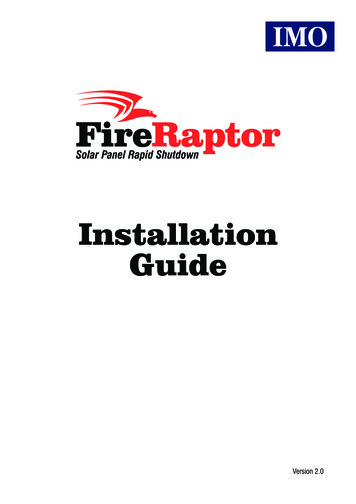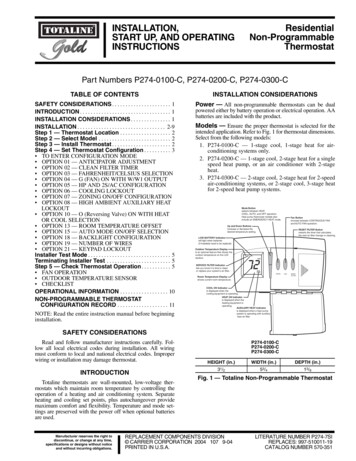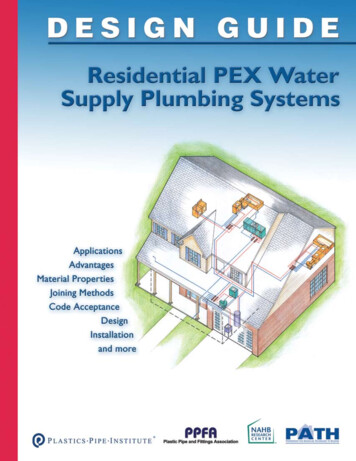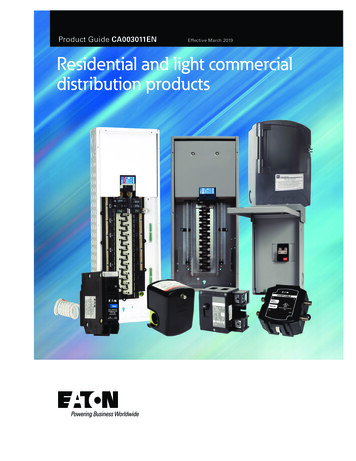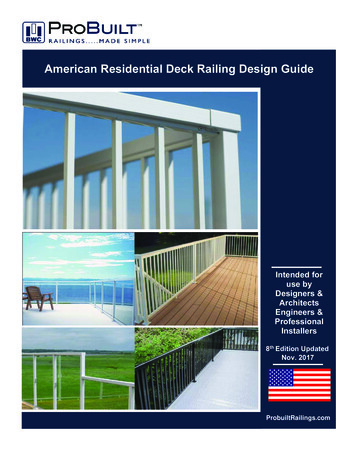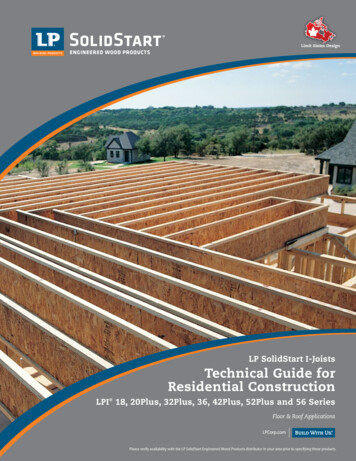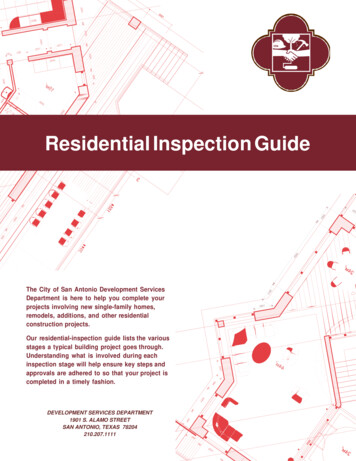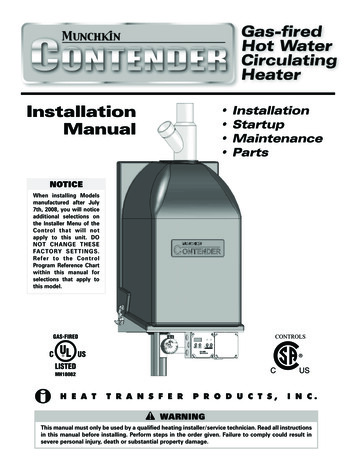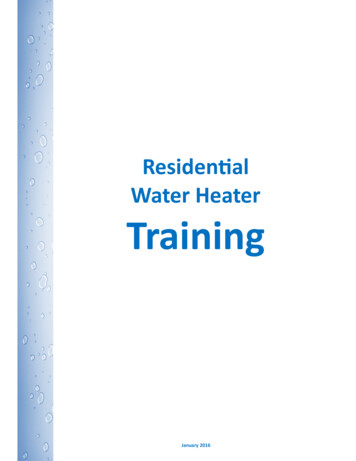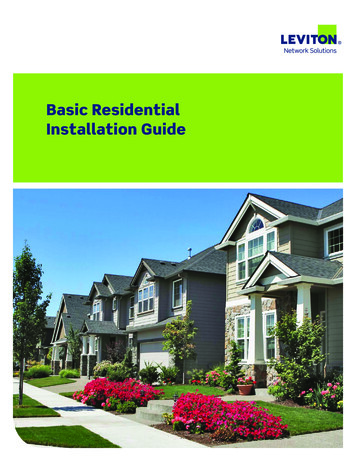
Transcription
Basic ResidentialInstallation Guide
Table of ContentsIntroduction11. Important Safety and Installation Information22. Local and Regional Considerations33. System Overview44. Description55. Accessories126. System Design167. Pre-Wire218. Trim Out309. Documentation, Testing, and Troubleshooting4010. Warranty46Glossary47Appendix52
IntroductionMore than ever, today’s homeowners are confronted with an expanded range of technologies and choices— with some hard decisions as a result. The three standard television channels of the 1950’s and 60’s, forexample, have exploded into hundreds of digital cable and satellite choices. With Ethernet quickly replacingtraditional satellite and cable options, video on demand and streaming video have given us the ability towatch almost anything at any time. Additionally, the quality of the incoming audio/video signal has evolvedto the point where the luxury of a home theater is increasingly considered a standard feature.On top of all these new incoming home technologies, age-old needs such as security, convenience,and comfort are raising homeowner expectations in every area. Smarter lighting, better power quality,tracking energy efficiency, and more comprehensive home control are just some of the applicationsmaking the leap from luxury to everyday use.For more than 100 years, the name Leviton has been synonymous with quality in connectivity. Frommultimedia panels to surge-protected AC outlets, from three-way lighting to Cat 5e and Cat 6 cabling,Leviton’s highest level of products, skills, and resources are combined to make upgrading simpler andmore sensible.LEVITON.COM 800.824.30051
1. Important Safety and Installation InformationFor All Telecommunications ApplicationsThere are special safety considerations with telephone wiring that may be unknown by workers new to thisfield. The following guidelines should be followed closely to help avoid safety hazards, and ensure trouble-freeinstallations and high-quality telephone service.This publication cannot, however, cover every aspect of safe installation and connection of telephone wiring.The contractor must follow local code requirements, including Article 800 of the National Electrical Code, andall rules or suggestions of the local telephone company and/or governmental and other regulatory agencies.High-Voltage Safety Test:Experienced electrician's, at first contact,always assume that hazardous voltages mayexist in any wiring system.A safety check, using a known, reliable voltagemeasurement or detection device, should be madeimmediately before work is started and whenever work isresumed on any job.Heart Pacemakers:Never attempt repair, installation, or modificationof telephone equipment or wiring systems if youwear a pacemaker. Pacemakers can be disruptedby telephone-circuit voltages and ringing-cycle frequencies.Lightning and High-Voltage Danger:Most electrical injuries involving telephonewiring result from sudden, unexpected highvoltages on normally low-voltage wiring.Installers may relax their normal care when handlingtelephone wire because it is a low-voltage system.However, telephone wiring can carry hazardous highvoltages under certain unsafe conditions. Never installor connect telephone wiring during electrical storms.Improperly protected telephone wiring can carry a fatallightning surge for many miles. Lightning exposure canalso be a danger to telephone users. Therefore, jacksshould never be installed in a position that would allowtelephone use by a person while in a bathtub, hot tub, orswimming pool. All outside wiring must be equipped withproperly grounded and listed signal circuit protectors.These protectors must be installed in compliance withthe requirements of the local telephone company andapplicable codes. Do not remove or modify protectors orthe grounding wire placed by the telephone company.Connections to telephone company independent groundingsystems can be made only with the approval of the localtelephone company. Do not run open wiring betweenstructures where it may be exposed to lightning withoutproper protection. Avoid wiring in or near damp locations.2LEVITON.COM 800.824.3005Wire Separations:Telephone wiring systems must be installed tominimize the possibility of accidental contactwith hazardous power and lighting wiring. Neverplace telephone wiring near bare power wires or lightningrods, antennas, transformers, steam or hot water pipes, orheating ducts. Never place telephone wire in any conduit, box,channel, duct, or other enclosure containing power or lightingcircuits of any type. Always provide adequate separation oftelephone wiring and other electrical wiring according to code.When in doubt about separation distances, the “Rule of Sixes”can be used. This rule requires six feet of separation betweentelephone wiring and open, high-voltage wiring, lightninggrounding wire, or grounding rods. It requires six inches ofseparation from all other high-voltage wiring unless in conduit.Avoiding Shocks:Fifty (50) to sixty (60) volts DC is normallypresent on an idle tip-and-ring pair. Ninety(90) volt AC ringing current can deliver anuncomfortable shock under certain circumstances.Consequently, always use insulated tools and avoid allcontact with bare terminals and grounded surfaces.To avoid being shocked, always disconnect the dial-toneservice from the premise wiring while working. If youcannot disconnect, take the telephone handset (receiver)off hook. The DC level will drop and normally no AC ringingcurrent will be delivered (be sure to replace the handsetwhen work is completed).Metallic Surfaces: Special caution is required when runningtelephone wire on or near metallic siding. Always check forstray voltages present on any metallic surfaces.Cutting and Drilling: Always observe trade safety rulesfor concealed wiring. Be extremely careful not to cutthrough or drill into concealed wiring or pipes. Make a smallinspection opening before cutting or drilling.Splicing: Common wire-splicing techniques may cause thewire to break and result in poor circuit integrity. This cancause interference in the form of static and noise on the line.Clean Contacts: Dust or dirt can cause special problems ontelephone wiring contacts. Be sure all contacts are cleanand that all parts are installed correctly to protect themfrom dust and dirt.
2. Local and Regional ConsiderationsLocal Ordinances, Covenants, and Service Provider Coordination2.1 Local OrdinancesLocal ordinances require adherence to national and localelectrical codes when installing AC and, in many instances,low-voltage wiring and devices. Make sure you follow alllocal ordinances and codes according to the AuthorityHaving Jurisdiction (AHJ) when installing a LevitonConnected Home system. For example, this manual refersto the use of mud rings instead of electrical boxes forlow-voltage wallplate locations. Your local area may requireelectrical boxes and conduit for all low-voltage wiring.In these cases, be sure to substitute the appropriatetype and size of outlet boxes and conduit to comply withlocal ordinances. Remember to use boxes and conduit ofsufficient size to accommodate and meet the cable pull,cable fill, and cable service loop requirements listed inChapters 5 and 6 of this Installation Manual.2.2 Covenants and Builder ConsiderationsYour local community may have certain covenantsthat specify location of service entrance and/ordemarcation points for CATV, telephone, and otherspecial communications services. External jacks and TVantenna outlets also may be restricted. External satelliteantenna, TV antenna, and outdoor speaker locations maybe restricted, prohibited, or limited to certain locations inyour area.In addition to local covenants, your builder may havedesign requirements specifying the location of centralwiring locations (the location of the Leviton StructuredMedia enclosure within the home). Also, the builder mayspecify the number and location of various wallplates,telephone, data communications, and Community AntennaTelevision (CATV), Digital Satellite Service (DSS), ortelevision (TV) jacks.Be sure to check that your plans meet all local covenantsand builder specifications during the planning andinstallation of Leviton Connected Home systems.2.3 Service Provider CoordinationThe telephone, CATV, and other communications serviceproviders serving your site may have special requirementsand services that you should know about prior to planningand installing Leviton Connected Home systems.Be sure to check the availability of Integrated ServicesDigital Networks (ISDN) and Asynchronous DigitalSubscriber Line (ADSL or DSL) services from localtelephone service provider(s). Availability of theseservices will dictate the number of Cat 5e cables from thedemarcation point to the Structured Media enclosure, thetype of components in the enclosure, and certain wallplateconfigurations within the home. Your builder may specifycertain Leviton Connected Home packages based on theavailability of these services.Alarm security services may also have a servicedemarcation point, separate from normal telephoneservice. Please check with a local security servicesprovider to see if any such services will be offered.CATV may or may not be offered in your building area. Ifnot available immediately, CATV service is often added ata future date and the wiring plan should provide for CATVservice from a demarcation point into the house.Please check with the CATV provider to determine thenumber of service entrance cables you will need. Insome communities, two or more cables may be requiredto offer alternative CATV services, or to providean increased number of cable channels. You mustduplicate the number of required cables from the CATVdemarcation point to the SMC and to the CATV jacksin the home. Typically, the CATV provider will providea signal level of 0 dBmV to 15 dBmV. The signal levelat the demarcation point will dictate whether a videoamplifier is required prior to video splitters.If CATV is available, check to see if cable modems areavailable for high-speed Internet access. Some cablemodem providers want a direct run from the CATVdemarcation point to the location of the cable modem.A TV antenna and/or Direct Service Select (DSS) antennaand provision for DSS distribution throughout the homefrom the SMC is not just an alternative to CATV. Yourplanning and installation should include provisions forDSS even though CATV is available. Many homeownerswant either an alternative to CATV, or both CATV and DSSservices. HDTV reception may also need to be considered.The DSS antenna may require one, two, or four RG-6 quadshielded coax cables to the SMC, and from there to DSSreceiver locations. Most RG-6 quad-shield cables for videoand TV distribution within the home use a copper-cladsteel core to provide optimum video signal performanceand cable strength. However, for the coax cable thatconnects the satellite antenna to the satellite receiver,many DSS manufacturers recommend solid copper-coreRG-6 quad shield because the cable must carry power(voltage switching) to switch LNBs at the antenna. Makesure you understand the requirements for your installation.Also, a telephone jack is required at each DSS receiverlocation. An off-air TV antenna may require one or twocables to the SMC, and from there to TV locations. Whenplanning external antennae or satellite dishes, make sureto take all necessary grounding, mounting, and lightningprotection precautions that may be required in your region.LEVITON.COM 800.824.30053
3. System OverviewStructured Media Structured Media refers to a system that supports the range of information, communication, andentertainment technologies available to the modern home—including telephone, high-speed Internet,cable and satellite TV (analog and digital), and more. Leviton’s Structured Media System takes theconcept of structured cabling, as practiced in demanding commercial applications for business andoffice networking, and combines it with multimedia to accommodate the convergence of audio/video,Wi-Fi , tablets, personal computers, telephone, Internet services, and more.Most important, Leviton’s Structured Media program gives end users a standards-compliant system —an important consideration today where inadequate or substandard performance may mean a lot morethan a call-back. Each properly installed Leviton subsystem is designed to meet ANSI/TIA-570-C, themost stringent residential standard proposed by the Telecommunications Industries Association.4LEVITON.COM 800.824.3005
4. DescriptionDescription of the Leviton Connected Home Structured Media SystemLeviton Connected Home Systems are composed of a series of smaller subsystems. The Structured Mediasystem covers all of your data, telephone, and entertainment needs. This system or infrastructure comes withthe following: A Structured Media enclosure or centralized distribution panel Modules for data, telephone, audio, video, and entertainment end-use devices Stylish wallplates with snap-in connectors at the points of termination Capability to add application modules to infrastructure platforms to address multi-room audio froman entertainment center, home-monitoring video cameras, and other applications Various modules or origination points for your structured cabling4.1 Structured Media Enclosures SMC 21" enclosure4.1.1 14" and 21" Structured Media Enclosures14" and 21" enclosures are professional-grade, whole-housemedia enclosures well suited for a condo or typically sizeddetached home. Each can accommodate two Pre-ConfiguredStructured Cabling Panels or an assortment of both full- andhalf-width expansion modules. Two or more 14" enclosurescan be combined for larger installations, or you could usethe 21" model for similar applications. SMC 28" enclosureDetails SMC 42" enclosure Enclosures with covers are sold separately or as a kitthat includes your choice of Pre-Configured StructuredCabling PanelThe Structured Media Center is a consolidation panel forlow-voltage wiring. All your points of origination are neatlyand safely contained in one protected box. Leviton offersthe following Structured Media enclosures: SMC 14" enclosure 30" RF Transparent enclosureIt is important to size the Structured Media enclosureaccurately to your job specifications. Several factorswill influence the complexity of your structured cablinginstallations including: The size of the dwelling The requirements of your customer Your job budgetInstaller Tip: The enclosure works for new construction and retrofitsbecause it can be either surface mounted or recessedbetween wall studs Structured media enclosures are constructed withwhite powder-coated steel with covers featuring a3/4-inch overlap to hide irregular drywall openingsA 14" SMC enclosure will typically serve a two-bedroomcondominium, apartment, or townhouse.The future will be filled with more low-voltage appliancesand devices, not fewer. Keep expansion in mind when youdiscuss the system installation.LEVITON.COM 800.824.30055
4.1.2 28" and 42" Structured Media EnclosuresThe 28" enclosure is designed for expanded installations.Using the 28" enclosure in an infrastructure installationensures “room to grow.” Remember, the main differenceamong the enclosures is the size of the enclosure and ACpower options. The 28-inch length provides abundant roomfor up to eight individual distribution modules (sizes anddensity of the modules will vary). This means you can use asingle distribution center for all the latest technology suchas home networking, security cameras, and multi-roomaudio. The enclosure's top and bottom panels featuremultiple knock-outs throughout for ease of cable routing.The 28" enclosure is designed to accommodate the Leviton ACPower Module and Universal Power Supply with power-surgesuppression for all internal electronic modules connected to it.Details Large capacity can service more intricately wired homes Accommodates quarter, compact, and standardexpansion modules, with both horizontal and verticalplacement for most modules The enclosure is constructed with white, powder-coatedsteel. The cover features a 3/4-inch overlap to hideirregular drywall openingsFor a three-bedroom, single-family home with a 28"enclosure, Leviton suggests the following components tomeet most homeowners’ basic structured cable needs: AC Power Module Basic Home Networking Plus Unit consisting of TelephonePatching Expansion Module, Cat 5e or Cat 6 Voice/DataModule, and 1x6 Video Splitter with TerminatorsThe 42" enclosure is Leviton’s largest enclosure. It canaccommodate several panels and modules, allowing itto manage many high-tech functions simultaneously. Itsdimensions and details are similar to the 28" enclosure,except for its greater length.The 28" and 42" Structured Media enclosures canaccommodate a varying array of individual distributionmodules from Leviton’s Connected Home Structured Medialine including: Premium Splitters, P/N 47693-31P, 08P, 16P, and 01P forCable Distribution 1x6 Passive Audio Module, P/N 48211-6A Passive 1x6 and 1x8 Video Splitters,P/Ns (2 GHz) 47690-6C2, 47690-8C2 5- and 8-Port Switch 47611-5PT, 8PT, 5GB Router, and47611-WG4 Audio Distribution, System Matching Module,and Volume ControlsA Large Home Configuration for a four-bedroom homewould include the following components in a 42" enclosure: AC Power Module, P/N 47605-DP Advanced Small Office Unit consisting of two Cat 5eVoice and Data Modules, a Telephone DistributionModule, a 1x6 Video Splitter, P/N 47606-ASOThis infrastructure will accommodate a maximum of twelvetelephone locations or twelve data locations, and six videolocations. You can expand the system to accommodatemore telephone, data networking, and video locations byadding more modules.6LEVITON.COM 800.824.3005
4.1.3 RF TransparentStructured Media EnclosureThe RF Transparent StructuredMedia Enclosure provides anexcellent termination and mountinglocation for in-home structuredwiring systems and components.The enclosure uses ABS polymerconstruction to permit the fullreach of a wireless network,as opposed to standard metalenclosures that can limit the rangeof a wireless signal.4.2 Data and Telephone DistributionLeviton makes your work easier by offering Pre-ConfiguredStructured Cabling Panels assembled from the mostpopular distribution modules. These are your system’sbasic building blocks. The panels and modules can becombined easily to meet any job’s specifications.Details 180-degree hinged cover allows for quick and easyaccess to network equipment Makes servicing and expansion easy with twelve 1-inchentry/exit ports and additional 11/4-inch removable tabsfor conduit adapters Compatible with Leviton Connected Home patchpanels, voice, data, video, and audio quick-connectdistribution modules Assures safety with UL compliant ABSflame-retardant polymer 30-inch height for added equipment space Allows for installation of two single-gang J-boxes4.1.4 Covers and Vented DoorsThe vented hinged door provides improved airflow andcooling of active gear, and is available for all LevitonStructured Media enclosures.Details 180-degree hinged cover allows for quick and easyaccess to network equipment Assists in airflow for coolingThese panels include combinations of the following modules: 1x9 Bridged Telephone Module bridges up to fourtelephone lines and out to nine telephone jacks (Pleasenote that bridged telephone connections are for voiceonly and do not conform to the ANSI/TIA-570-C standardfor Cat 5e or Cat 6 data wiring; these bridged telephonelines cannot be tested for Cat 5e or Cat 6 complianceusing Cat 5e or Cat 6 field test sets Cat 5e Voice and Data Module whose six Cat 5e or Cat6 ports allow for basic home networking (data, phone,fax, or modem) and can be connected to a TelephoneDistribution Module, key system, or network switch 1x6 Video Splitter that is suitable for both cable TVand off-air antenna signalsÆTake Not
concept of structured cabling, as practiced in demanding commercial applications for business and office networking, and combines it with multimedia to accommodate the convergence of audio/video, Wi-Fi , tablets, pe
